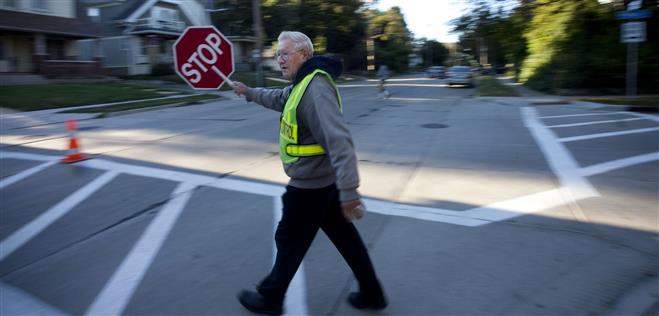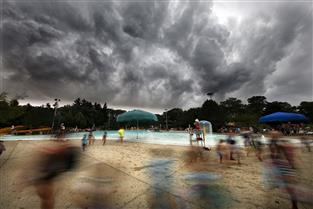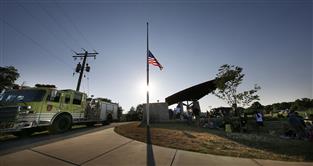Standing up to traffic for the sake of kids
Like a lifeguard or a security guard, crossing guards live at the juncture of boredom and panic. For two hours every school day, they sometimes stand for long minutes, waiting for kids to arrive. When they do, a guard's job means negotiating a stopping point with often impatient drivers, using only their eyes, their stop signs and their steps into oncoming traffic.
For Chuck Cooney, in his second year as a guard, it's not about the money.
"You do this partly because you like kids, and it's a nice job — you're helping save lives. It's a job for retirees who are looking for loose change," he said.
While the city of Wauwatosa pays $16.31 per hour per guard to its contractor, Twin City Security, Cooney is near the lower end of the 8 to $10 an hour pay range. Like all city crossing guards, he works about two hours a day.
Retired after a teaching career that included 25 years in the Milwaukee Public Schools, Cooney is an energetic 70-year-old who likes to get out of the house. He walks nearly a mile each way to and from his posting, at 73rd Street and North Avenue, giving him four miles daily. His intersection sees, in an official company count, 285 crossings a day for students who mostly attend Roosevelt Elementary, Longfellow Middle School and Tosa East High School.
Cooney is the contractor's ideal employee.
"The crossing guards are generally someone that's not doing it as much for the income, more so because they want to get out there and do it, because they're not making a ton of money," said Jerry Mojeck, a partner in Twin City Security. "They're only working a couple hours a day — it's extreme part-time, very common for retired people and things like that."
Not just the retired
There are others, though, for whom the job is not just loose change.
Cathy Klotzbuecher, who supervises crossings at Milwaukee and Underwood avenues, said the job is "one of the only ones I could get."
The crossing count at her intersection is 419 a day — she said she sees about 150 kids in a one-hour shift — making it one of the city's busiest crossing points, with kids going to Lincoln Elementary School, at the corner, and walking a block east to Tosa East.
She's been at it for about four years, and thinks her hourly wage, compared to the company's take is "wrong," she said. She acknowledged the company has overhead — equipment, rain gear, liability insurance, worker's compensation — but said to only get about half what the company is collecting doesn't seem fair.
Despite a crossing guard's split shift that makes holding another day job nearly impossible, Mojeck said, recruiting isn't that difficult, and turnover is only about 10 percent a year.
Dangerous, but essential
It's a dangerous, and, for parents of school-age kids, utterly essential service.
It's commonplace to encounter drivers who accelerate to pass Cooney when he's moving into the intersection, he said — or are looking at their phones,eating, and/or following too closely behind the vehicles ahead of them.
"Very few drivers are doing anywhere near 25 miles an hour" — the speed limit at that point on North — Cooney said. He tries not to think about the danger, but in just one school year, he has seen four fender-benders happen in front of him, and had a car knock the stop sign out of his hand.
Drivers yell, complain that bikers shouldn't get the protection the pedestrians do, and, in general, "know how to do your job better than you do," he said.
Klotzbuecher concurs.
One day, "we were walking out, and I had my sign up, and the guy was looking (away), he wasn't looking at me, and he almost hit me, and he goes, 'Oh, I'm sorry.' I said, 'You're sorry? You could have killed me.'"
She said drivers frequently roll through the wide white line that indicates where they should stop before hitting the crosswalk.
"This one lady, she came and she didn't look like she was going to stop, and I yelled at her, I said, 'Stop!' And I had my sign up and everything, and before she took off to make her left-hand turn, she said, 'You don't have the right to yell at me!'"
Klotzbuecher said she'll yell if she has to. Cooney said he too has to yell on occasion. "But of course their air conditioner (is on), they have their windows up, so nobody's hearing me."
Getting to know the kids
Over time, the guards get to know some of the kids. Klotzbuecher said she always watches for a couple of boys on bicycles she calls her legal team because their names sound like a law firm. Cooney said he knows all his kids by sight, and knows the names of 15 to 20 of them.
"The kids are not a problem. It's the drivers," Cooney said. "The kids are incredible, really. There are three different schools, and the older ones look out for the younger ones."
The recent discussion at City Hall about cutting two of its 36 crossing guards to save money was a big problem for the guards, and also parents.
"Kids are crossing pretty major intersections," said Ginnie Perhach, whose first-grade daughter crosses Klotzbuecher's intersection to attend Lincoln.
Jeff Edwards, a grandfather who picks up his granddaughter, a second-grader at Lincoln, after school, said he always waits for Klotzbuecher's direction before crossing the street, even when he could do it safely on his own.
"There's two things: She's in command of this intersection, and you have to model good citizenry for the kids, because they're always watching and you don't know it."
More from News and Features
- Anodyne Coffee plans to open location in Wauwatosa Village
- Wauwatosa Meetings: Aug. 4
- Video: Wauwatosa girl's curbside ice cream stand raises money for the hungry
- Wauwatosa News and Notes: Hands-only CPR training offered; Firefly Art Fair is Aug. 6-7
- Wauwatosa Ask Now: Why are there barriers and fencing along the North Avenue bridges over the Menomonee River?
- Mystery Photo Contest: July 28
- Wauwatosa gears up for National Night Out event, this year at the zoo
- Election 2016: Wisconsin's 4th District candidates weigh in
- Wauwatosa's Luther Manor residents share smiles through flower delivery
- Wauwatosa Police Report: July 17-23















